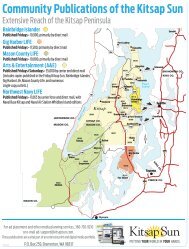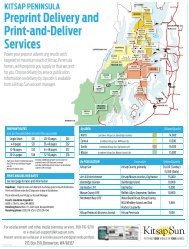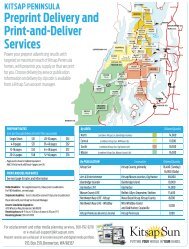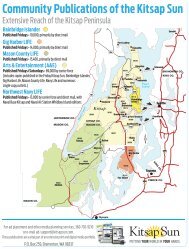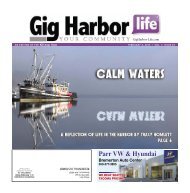Northwest Navy Life - Example Publication
Northwest Navy Life is a weekly publication of the Kitsap Sun.
Northwest Navy Life is a weekly publication of the Kitsap Sun.
Create successful ePaper yourself
Turn your PDF publications into a flip-book with our unique Google optimized e-Paper software.
4 | FEBRUARY 6, 2015 NORTHWEST NAVY LIFE | KITSAP<br />
NWNAVYLIFE.COM<br />
Commission:<br />
offer choices and<br />
see compensation<br />
costs fall<br />
MILITARY UPDATE<br />
Tom Philpott<br />
The Military Compensation and Retirement Modernization<br />
Commission is urging President<br />
ObamatoendorseandCongresstoenactsweeping<br />
changes to military health insurance and retirement<br />
options to “empower” service members to make<br />
choices that would drive down compensation costs.<br />
The panel’s final report makes 15 recommendations<br />
that, if fully implemented, would cut personnel spending<br />
for the departments of Defense and Veterans Affairs by<br />
$12 billion a year. The most surprising idea is to replace<br />
the triple-option TRICARE program for military families<br />
and working-age retirees with a selection of commercial<br />
health insurance plans.<br />
On retirement, current force members could stay<br />
under their High-3 plan. But the commission forecasts<br />
40 percent of them, if given a chance, would replace that<br />
plan offering no benefits before 20 years’ service with a<br />
“blended” plan that lowers annuities for careerists but offers<br />
some retirement savings to the 83 percent of service<br />
members who leave short of 20 years.<br />
That menu of health insurance offerings to the military<br />
would be similar to the Federal Employees Health Benefits<br />
Insurance Program (FEHBP) for civilians. Indeed<br />
the Office of Personnel Management, which administers<br />
FEHBP, would also run the military plans. But rather<br />
than saddle active duty families with the same costs paid<br />
by civilians – roughly 28 percent as premiums – they<br />
would receive a new two-part Basic Allowance for Health<br />
Care (BAHC) to cover at least most of their new health<br />
insurance costs.<br />
One part would be paid to the selected insurance plan directly<br />
and cover member premiums for an average-priced<br />
plan. Part two of BAHC, to cover co-pays and deductibles,<br />
would go to members to use as they choose. The intent of<br />
those dollars is to incentivize military families to be careful<br />
consumers of health care. They are not today, the report<br />
says. TRICARE Prime users, for example, make 55 percent<br />
more outpatient visits than do civilians enrolled in HMOs<br />
who have to cover co-pays out of pocket.<br />
Participating insurance plans would have to include<br />
military treatment facilities in their provider networks.<br />
Patients and plans would be enticed to use on-base care<br />
with offers of reduced co-pays and fee reimbursements,<br />
particularly for complex medical cases that keep wartime<br />
skills sharp.<br />
TRICARE administrative costs are excessive, the report<br />
says, and yet too many beneficiaries don’t get timely<br />
care or quality care. Also, TRICARE provider networks<br />
have coverage gaps because contractors set physician<br />
fees too low. Relying on commercial insurance would<br />
improve access, speed referrals for specialty care, save<br />
millions of dollars in administrative costs and leave beneficiaries<br />
more satisfied, the commission predicts.<br />
VIEWPOINTS<br />
The commission would leave unchanged TRICARE<br />
for <strong>Life</strong>, the golden supplement to Medicare that elderly<br />
retirees have prized for a dozen years.<br />
Working-age military retirees and families, however,<br />
would fare less well. Initially they would have to pay 5<br />
percent of health plan premiums. That cost share would<br />
grow by one percentage point a year over 15 years so that<br />
retirees under age 65 eventually pay 20 percent of health<br />
insurance costs. The costs would stop when eligible for<br />
Medicare and TRICARE for <strong>Life</strong>.<br />
Commissioners say beneficiaries, from during their site<br />
visits and public hearings, expressed a desire for more<br />
health care choices than the ponderous TRICARE program<br />
can provide.<br />
The retirement plan they propose for new entrants and<br />
for any current members drawn to its features would still<br />
provide an immediate although reduced annuity after 20<br />
or more years’ service. But among its new features would<br />
be a Thrift Savings Plan with government matching of<br />
member contributions up to 5 percent of monthly basic<br />
pay. This would be portable like 401k plans in the private<br />
sector. TSP would vest after only two years and members<br />
could roll it into civilian employer 401ks on leaving<br />
service.<br />
Also, 12 years into a military career, members would<br />
receive a lump-sum “continuation” payment, equal to at<br />
least two-and-a-half months of basic pay, more if they<br />
have a critical skill. To take the cash, members would<br />
have to agree to serve four more years. Presumably 16<br />
years in, most careerists would decide to serve for at least<br />
20 years to gain the immediate annuity. But with the new<br />
plan retiring members would have more choices.<br />
They could draw an immediate annuity based on 2<br />
percent (not the current 2.5 percent) of average basic pay<br />
for each year served; or accept a lump sum amount and a<br />
smaller annuity; or accept a full cash out and forego any<br />
military annuity until they age into social security.<br />
At that point, military retired pay would start and equal<br />
the retired pay of their peers who elected to draw full annuities<br />
since time of retirement.<br />
The nine-member commission, including two retired<br />
generals and four former members of Congress, endorses<br />
current basic pay tables and the tradition of paying taxfree<br />
allowances for housing and subsistence. They also<br />
unanimously recommend streamlining, not dismantling,<br />
commissary and exchange systems to preserve current<br />
on-base shopping discounts.<br />
Other recommendations would strengthen support<br />
of families with more childcare and improved access to<br />
services for special needs children.<br />
The commission doesn’t endorse ending the offset of<br />
Survivor Benefit Plan payments for thousands of widows<br />
who also receive VA Dependency and Indemnity Compensation<br />
(DIC). But it would give retirees the option<br />
of paying higher SBP premiums to ensure that their<br />
surviving spouses, if deemed eligible for DIC, would also<br />
receive full SPB.<br />
Commission ideas to “safeguard” the Post-9/11 GI Bill<br />
could spark some of the sharpest protests from military<br />
and veterans associations. One would impact many of the<br />
more than 423,000 members who have elected to transfer<br />
GI Bill benefits to family members in return for serving<br />
longer. The transferred benefit now includes a housing<br />
stipend equal to monthly housing allowance locally for a<br />
mid-grade enlisted member. The commission says that<br />
stipend shouldn’t be paid to family member students<br />
after June 2017 even if it was part of the original deal.<br />
Next week: Commissioners present and defend these<br />
proposals and more before the Senate and House armed<br />
services committees.<br />
Contact Tom Philpott at P.O. Box 231111, Centreville,<br />
VA, 20120, or milupdate@aol.com.<br />
NORTHWEST NAVY LIFE<br />
is produced each Friday by the Kitsap Sun at<br />
545 Fifth St. Bremerton WA 98337.<br />
PUBLISHER:<br />
Brent W. Morris<br />
EDITORIAL DIRECTOR:<br />
David Nelson, david.nelson@kitsapsun.com<br />
SPECIAL PUBLICATIONS EDITOR:<br />
Steve Johnson<br />
EDITOR:<br />
Richard Bartlett, editor@nwnavylife.com<br />
For advertising or delivery inquiries (toll free):<br />
From Whidbey 360.279.8888<br />
From Kitsap 360.792.9210<br />
Classified ads:<br />
360.792.3333, 360.792.9237 (fax)<br />
classifieds@kitsapsun.com<br />
MC3 IGNACIO PEREZ<br />
Wired | Sailors move an arresting gear wire<br />
on the flight deck of the Nimitz-class aircraft<br />
carrier USS John C. Stennis (CVN 74). John C.<br />
Stennis is undergoing an operational training<br />
period in preparation for future deployments.<br />
Standard mail postage to be paid at Bremerton, WA<br />
POSTMASTER: Send address changes to Kitsap Sun, PO Box 259,<br />
Bremerton WA 98337-1413<br />
© 2014 <strong>Northwest</strong> <strong>Navy</strong> <strong>Life</strong> / Kitsap Sun<br />
ISSN 1050-3692 VOLUME 2, NUMBER 45




